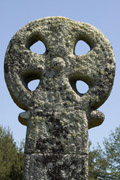Select a site alphabetically from the choices shown in the box below. Alternatively, browse sculptural examples using the Forward/Back buttons.
Chapters for this volume, along with copies of original in-text images, are available here.
Object type: Cross-head and part of -shaft
Measurements: H. 122 cm (48 in); W. 48 cm (19.2 in) (shaft); D. 32 cm (12.8 in) (shaft)
Stone type: Fine-grained granite with small feldspar megacrysts up to 1 cm across, and quartz up to 6 mm across. Bodmin Moor Granite
Plate numbers in printed volume: Ills. 8-12, 351
Corpus volume reference: Vol 11 p. 121-2
(There may be more views or larger images available for this item. Click on the thumbnail image to view.)
Cross-head and part of shaft, of rectangular section, set on a modern shaft and in a modern base. The cross-head is circular, of type E8, with splayed arms and a ring, type b. At the neck of the cross-head are slightly recessed projections, rather pointed in shape. Both head and shaft are enriched with incised dot decoration.
A (broad): The cross-head has a double incised edge-moulding. In the centre of the arms is a boss surrounded by a raised band. The cross-arms are covered with irregularly placed incised holes. On the shaft is a double incised edge-moulding, which curves inwards at the top to form a hook. Within this is decoration consisting of randomly arranged incised small holes.
B (narrow): No ornament on head. Inside a double incised edge-moulding are three rows of incised holes.
C (broad): The cross-head has a double incised edge-moulding. In the centre is a rather worn boss surrounded by a raised band. Each of the cross-arms has the worn remains of a smaller boss surrounded by a raised band, set asymmetrically on the cross-arms. The shaft is covered with irregularly placed incised holes, set between a single incised edge-moulding which curves inwards at the top.
D (narrow): As side B, except that the dots are more randomly placed.
The size of this cross-head is similar to Cardinham 1 and Padstow 3 (Prideaux Place) (Ills. 43–6, 169–72), suggesting that originally it was a large and impressive monument. Although now mounted on a modern shaft, it is possible that the 3.65 m high modern monument is close to the scale of the original.
In style, however, the cross is rather different from Cardinham 1 and Padstow 3, being closer to the monuments likely to be transitional between early and later medieval styles (Chapter IX, p. 95). The circular, possibly compass-drawn, head with protruding roll-mouldings at the neck, set on a tall slender shaft, can be compared with the very eroded Perranzabuloe 1 cross, or Lanteglos by Camelford 2 (Ills. 193–6, 136–7), while the cross on the head, indicated by triangular-shaped holes, is of similar shape to Lanivet 2, Penzance 1, or again Lanteglos 2 (Ills. 120–3, 185–8). Incised dot-decoration is found on all of these monuments, although on Bodmin 1 (the Carminow Cross) the dots have escaped from the shaft and like a rash, pock the head as well. The five bosses, though an insignificant feature on the head, may reflect influence from west Cornwall, where bosses appear on most crosses of the Penwith group (Chapter IX, p. 85).
Despite these parallels, this is a difficult cross to place with certainty in either the early or later medieval periods. The probable size of the original monument allies it with the early medieval crosses: of the later medieval crosses, only that at Mylor is likely to have been taller (Langdon, Arthur 1896, 342–3), whereas a number of pre-Norman crosses may have been of similar stature. Yet the decoration of incised dots is purely decorative and can have no possibility of a relationship with interlace in the way that has been suggested for monuments like Lanivet, Penzance and Perranzabuloe. Nonetheless its close relationship to these monuments is apparent (see Chapter IX, p. 98) and for this reason it has been kept in the main catalogue, rather than being listed in Appendix D, Continuing Tradition.
In its original position, at approximately SX 0882 6558, the cross marked the boundary between the parishes of Bodmin, Lanhydrock (a chapelry of Bodmin) and Cardinham (Langdon, Andrew 1992a, 17), a boundary which probably also divided the Domesday manors of Trezance and/or Glynn from the manor of Bodmin, owned by St Petroc's Monastery (Thorn and Thorn 1979, 4,3; 5,3,3; 5,13,5). An original association with either St Petroc's Monastery or the Priory that replaced it in the twelfth century therefore seems likely. It also stood at what is likely to have been one of the most significant cross-roads in Cornwall, where routes along the length of the peninsula (now seen in the line of the modern A30) crossed the trans-peninsula route between the estuaries of the Camel and the Fowey rivers. The strategic significance of this location at earlier periods is indicated by the positioning of Castle Canyke, one of the largest hillforts in Cornwall, immediately to the north of the Carminow Cross.



